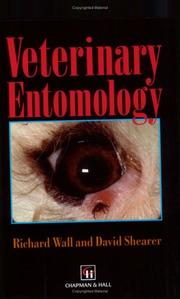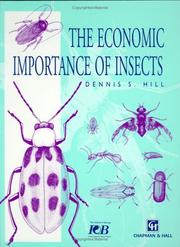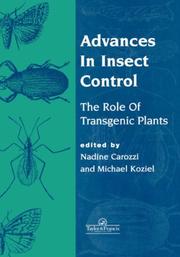| Listing 1 - 3 of 3 |
Sort by
|

ISBN: 041261510X 9780412615108 9401158525 Year: 1997 Publisher: London : Chapman & Hall,
Abstract | Keywords | Export | Availability | Bookmark
 Loading...
Loading...Choose an application
- Reference Manager
- EndNote
- RefWorks (Direct export to RefWorks)
Although usually treated as unified subject, in many respects the two components of what is broadly described as 'medical and veterinary is usual, the term entomology is entomology' are clearly distinct. As used loosely here to refer to both insects and arachnids. In medical entomology blood-feeding Diptera are of paramount importance, primarily as vectors of pathogenic disease. Most existing textbooks reflect this bias. However, in veterinary entomology ectoparasites such as the mites, fleas or dipteran agents of myiasis assume far greater prominence and the most important effects of their parasitic activity may be mechanical damage, pruritus, blood loss, myiasis, hypersensitivity and dermatitis, in addition to vector-borne pathogenic disease. Ectoparasite infestation of domestic and companion animals, therefore, has clinical consequences necessitating a distinct approach to diagnosis and control. The aim of this book is to introduce the behaviour, ecology, pathology and control of arthropod ectoparasites of domestic animals to students and practitioners of veterinary medicine, animal husbandry and applied biology. Since the book is directed primarily at the non-entomologist, some simplification of a number of the more involved entomological issues has been deemed necessary to improve the book's logical structure and comprehensibility, and keep its length within limits. A reading list is presented at the end of each chapter to act as a stepping-stone into the specialist literature.
Arthropod pests. --- Ectoparasitic infestations. --- Veterinary entomology. --- Veterinary parasitology. --- Plant and Crop Sciences. Agricultural Entomology and Acarology -- Medical Entomology --- ALLW. --- Animals, Domestic --- Ectoparasitic Infestations --- parasitology. --- veterinary. --- Animal systematics. --- Animal taxonomy. --- Animal anatomy. --- Animal Systematics/Taxonomy/Biogeography. --- Animal Anatomy / Morphology / Histology. --- Animal anatomy --- Animals --- Biology --- Physiology --- Animal classification --- Animal systematics --- Animal taxonomy --- Classification --- Systematic zoology --- Systematics (Zoology) --- Taxonomy, Animal --- Zoological classification --- Zoological systematics --- Zoological taxonomy --- Zoology --- Anatomy --- Veterinary epidemiology --- Arthropod pests --- Data processing. --- Control. --- Arthropoda --- Invertebrate pests --- Epidemics in animals --- Epizootiology, Veterinary --- Veterinary epizootiology --- Epidemiology --- Communicable diseases in animals --- Animals, domestic --- parasitology --- Plant and Crop Sciences. Agricultural Entomology and Acarology -- Medical Entomology.

ISBN: 0412498006 940106248X 9401153485 Year: 1997 Publisher: Lodon ; New York ; Madras Chapman & Hall
Abstract | Keywords | Export | Availability | Bookmark
 Loading...
Loading...Choose an application
- Reference Manager
- EndNote
- RefWorks (Direct export to RefWorks)
In the last few decades there has been an ever-increasing component in most BSc Zoology degree courses of cell biology, physiology and genetics, for spectacular developments have taken place in these fields. Some aspects of biotechnology are now also being included. In order to accommodate the new material, the old zoology courses were altered and the traditional two-year basis of systematics of the animal kingdom, comparative anatomy (and physiology) and evolution, was either severely trimmed or reduced and presented in an abridged form under another title. Soon after these course alterations came the swing to modular teaching in the form of a series of shorter, separate courses, some of which were optional. The entire BSc degree course took on a different appearance and several different basic themes became possible. One major result was that in the great majority of cases taxonomy and systematics were no longer taught and biology students graduated without this basic training. We field biologists did appreciate the rising interest in ecology and environ mental studies, but at the same time lamented the shortage of taxonomic skills, so that often field work was based on incorrect identifications. For years many of us with taxonomic inclinations have been bedevilled by the problem of teaching systematics to undergraduates. At a guess, maybe only 5% of students find systematics interesting. It is, however, the very basis of all studies in biology - the correct identification of the organism concerned and its relationships to others in the community.
Plant and Crop Sciences Agricultural Entomology and Acarology -- Agricultural Entomology and Acarology --- Entomology. --- Insect pests. --- Veterinary entomology. --- ALLW. --- Beneficial insects --- Destructive insects --- Economic entomology --- Entomology [Economic ] --- Injurious insects --- Insect pests --- Insecten [Schadelijke ] --- Insectes nuisibles --- Insectes utiles --- Insects [Beneficial ] --- Insects [Injurious and beneficial ] (UF) --- Nuttige insekten --- Schadelijke insecten --- Useful insects --- Forestry. --- Ecology . --- Medical microbiology. --- Plant pathology. --- Infectious diseases. --- Ecology. --- Medical Microbiology. --- Plant Pathology. --- Infectious Diseases. --- Botany --- Communicable diseases in plants --- Crop diseases --- Crops --- Diseases of plants --- Microbial diseases in plants --- Pathological botany --- Pathology, Vegetable --- Phytopathology --- Plant pathology --- Plants --- Vegetable pathology --- Agricultural pests --- Crop losses --- Diseased plants --- Phytopathogenic microorganisms --- Plant pathologists --- Plant quarantine --- Balance of nature --- Biology --- Bionomics --- Ecological processes --- Ecological science --- Ecological sciences --- Environment --- Environmental biology --- Oecology --- Environmental sciences --- Population biology --- Forest land --- Forest lands --- Forest planting --- Forest production --- Forest sciences --- Forestation --- Forested lands --- Forestland --- Forestlands --- Forestry --- Forestry industry --- Forestry sciences --- Land, Forest --- Lands, Forest --- Silviculture --- Sylviculture --- Woodlands --- Woods (Forests) --- Agriculture --- Natural resources --- Afforestation --- Arboriculture --- Logging --- Timber --- Tree crops --- Trees --- Pathology --- Diseases and pests --- Diseases --- Wounds and injuries --- Ecology --- Insects --- Zoology --- Entomology, Economic --- Insects, Injurious and beneficial --- Arthropod pests --- Veterinary entomology --- Entomology, Veterinary --- Insects as carriers of disease

ISBN: 0748404171 Year: 1997 Publisher: London Taylor and Francis Publishers
Abstract | Keywords | Export | Availability | Bookmark
 Loading...
Loading...Choose an application
- Reference Manager
- EndNote
- RefWorks (Direct export to RefWorks)
Phytopathology. Phytoparasitology --- Plant genetics. Plant evolution --- Insecte nuisible --- Pest insects --- Plante transgénique --- Transgenic plants --- Relation hôte parasite --- Host parasite relations --- Expression des gènes --- gene expression --- Bacillus thuringiensis --- Zea mays --- Oryza --- Lectine --- lectins --- Plante pesticide --- Pesticide crops --- Phaseolus --- Inhibiteur d'enzyme --- Enzyme inhibitors --- Résistance aux organismes nuisibles --- Pest resistance --- Génie génétique --- genetic engineering --- Insect pests --- -Plants --- GE crops (Genetically engineered crops) --- GE plants (Genetically engineered plants) --- Genetically engineered crops --- Genetically engineered plants --- Genetically modified crops --- Genetically modified plants --- GM crops (Genetically modified crops) --- GM plants (Genetically modified plants) --- Novel crops --- Transgenic crops --- Plants, Cultivated --- Transgenic organisms --- Plant genetic engineering --- Flora --- Plant kingdom --- Plantae --- Vascular plants --- Vegetable kingdom --- Vegetation --- Wildlife --- Organisms --- Botany --- Destructive insects --- Economic entomology --- Entomology, Economic --- Injurious insects --- Insects, Injurious and beneficial --- Arthropod pests --- Insects --- Veterinary entomology --- Biological control --- Insect resistance --- -Genetic aspects. --- Plants --- Biological control of insects --- Insect resistance&delete& --- Genetic aspects --- Control --- Plant genetics --- Cry3a endotoxine
| Listing 1 - 3 of 3 |
Sort by
|

 Search
Search Feedback
Feedback About UniCat
About UniCat  Help
Help News
News